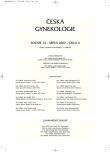Preeclampsia – possibly prediction markers
Authors:
J. Vokroj 1; L. Arnoštová 2
Authors‘ workplace:
Gynekologicko-porodnická klinika 1. LF UK a VFN Praha, přednosta prof. MUDr. A. Martan, DrSc.
1; Ústav lékařské biochemie 1. LF UK Praha, přednosta prof. MUDr. S. Štípek, DrSc.
2
Published in:
Ceska Gynekol 2009; 74(4): 256-261
Category:
Original Article
Overview
Objective:
The aim of our artical is give overwiew of prediction’s possibilities of preeclampsia. We give special attention to new markers.
Design:
Review article.
Settings:
Department of Obstetrics and Gynecology, First Faculty of Medicine, Charles University and General Teaching Hospital, Prague, Czech Republic, Institute of Medical Biochemistry 1st Faculty of. Medicine, Charles University, Prague.
Methods:
Compilation of published data from scientific literature.
Conclusion:
Recent etiology’s hypothesis of preeclampsia are based on connection between well know pathophysiology and recent biochemistry mechanism. It ways to show new markers which could be used for earlier diagnostics in future. We need to find markers existing before clinical signs.
Key words:
preeclampsia, prediction, prediction markers, oxidative stress, angiogenesis.
Sources
1. Arnoštová, L., Fialová, L., Malbohan, I., et al. Preeklampsie a její diagnostika. Klin biochem metab, 2007, 15, 4, p. 200-2006.
2. Bozrychowski, AM., Sargent, IL., Redman, CW. Inflammation and pre-eclampsia. Semin Fetal Neonatal Med, 2006, 11, p. 309-316.
3. Davari, T., Mohammad, P., Kaveh, M., et al. Prediction of preeclampsia with elevation in erythroblast count in maternal blood. Shiraz E-Med J, 2008, 9, 3.
4. Gonen R., Shahar R., Grimpel YI., et al. Placental protein 13 as an early marker for pre-eclampsia : a prospectice longitudial study. Brit J Obstet Gynecol, 2008, 115, 12, p. 1465-1472.
5. Hájek, Z. a kol. Rizikové a patologické těhotenství, 1.vyd. Praha: Grada, 2004, p. 95-107.
6. Hiby, S., Walker, J., O‘Shaughnessy, K., et al. Combinations of maternal KIR and fetal HLA-C genes influence the risk of preeclampsia and reproductive success. J Exp Med, 2004, 8, p. 957-965.
7. Chekir, C., Nakatskuka, M., Noguchi, S., et al. Accumulation of advanced glycation end products in women with preeclampsia: possible involvement of placenta oxidative and nitrative stress. Placenta, 2006, 27, p. 225.
8. Kang, JH., Farina, A., Park, JH., et al. Down syndrome biochemical markers and sreening for preeclampsia at first and second trimester: correlation with the week of onset and the severity. Prenat Diagn, 2008, 28, 8, p. 704-709.
9. Lam, C., Lim, K., Karumanchi, A. Circulating angiogenic factors in the pathogenesis and prediction of preeclampsia. Hypertension, 2005, 46, p. 1077-1085.
10. Levine, RJ., Maynard, SE., Quian, C., et al. Circulating angiogenic factors and the risk of preeclampsia. N Engl J Med, 2004, 350, p. 672-683.
11. Madazli, R., Kuseyrioglu, B., Uzun, H., et al. Prediction of preeclampsia with maternal mid-trimester placental growth factor, activin A, fibronectin and uterine Doppler velocimetry. Inter J Gynecol Obstet, 2005, 69, p. 251-257.
12. Moore Simas, TA., Crawford, SL., et al. Angiogenic factors for the prediction of preeclampsia in high-risk women. Am J Obstet Gynecol, 2007, 197, p. 244e-244e8.
13. Purwosunu, Y., Sekizewa, A., Okazaki, S. et al. Prediction of preeclampsia by analysis of cell free messenger RNA in maternal plasma. Am J Obstet Gynecol, 2009, 13 (abstrakt publikován před vydáním v tisku).
14. Rajasingam, D., Seed, PT., Briket, AL., et al. A prospective study of pregnancy outcome and biomarkers of oxidative stress in nulliparous obese women. Am J Obstet Gynecol, 2009, 5 (epub ahead of print).
15. Roberts, JM., Cooper, DW. Pathogenesis and genetics of pre-eclampsia. Lancet, 2001, 357, 9249, p. 53-56.
16. Soleymanlou, N., Jurisica, I., Nevo, O., et al. Molecular evidence of placental hypoxia in preeclampsia. J Clin Endocrinol Metab, 2005, 90, p. 4299-4308.
17. Spinnato, JA. 2nd., Freire, S., Pinto E., et al. Antioxidant therapy to prevent preeclampsia: a randomized controlled trial. Obstet Gynecol, 2007, 110, 6, p. 1311-1318.
18. Tjoa, ML., Oudejans, CB., van Vugt, JM., et al. Markers for presymptomatics prediction of preeclampsia and intrauterine growth restriction. Hypertens Pregnancy, 2004, 23, p. 171-189.
Labels
Paediatric gynaecology Gynaecology and obstetrics Reproduction medicineArticle was published in
Czech Gynaecology

2009 Issue 4
Most read in this issue
- Vaginal combined contraception NuvaRing in the clinical practice in the Czech Republic
- Placenta adherens partim accreta
- Long-term review on posterior colporrhaphy with levator ani muscles plication and incorporating a Vypro II mesh
- Level of CA125 and hemoglobin as prognostic factors ovarian cancer
